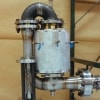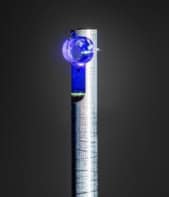A curious phenomenon responsible for the "singing" made by hot glass vessels during the glass blowing process could soon provide the world's poorest communities with everyday conveniences such as a cooker, a fridge and a generator -- all combined within one unit and powered by simple biomass fuels such as wood.

Scientists have long known that sound waves can be generated by irregularly heating a pressurized gas. Now, a new £2m project called SCORE (Stove for COoking, Refrigeration and Electricity supply) is aiming to exploit this “thermoacoustic” principle to develop an affordable and versatile wood-powered generator that will be capable of both cooking and cooling food across the developing world where access to power is severely limited.
The project is being run by leading UK and US researchers along with the charity Practical Action, industry and universities across Africa and Asia. “Though the physical principles are well-understood and the technology has been used before to provide power sources or cooling units on satellites, there has been no research into producing a combined device that can be mass-produced at a reasonable price,” said SCORE researcher Mark Johnson of the University of Nottingham.
In the planned appliance, wood is burnt beneath a gas-filled pipe containing a porous “stack” of small parallel channels. As the gas heats up, it creates a temperature gradient across the stack. This causes the gas molecules to oscillate back and forth against the channel walls, exchanging heat and producing areas of high and low gas pressure, which generate intense sound waves like a singing kettle. Then, as the gas is constantly shifting to and fro between the hot and cold sections of the pipe, it begins to “rhythmically” compress and rarefy, thus enhancing the sound waves.
These sound waves can be harnessed in a linear alternator – akin to a loudspeaker operating in reverse – which converts them into electricity. However, they can also be passed to another thermoacoustic engine working backwards to generate a cooling effect. Here, the gas effectively picks up heat from one end of the pipe, transports it, and drops it off at the other. The ensuing cool part can then be used as a refrigerator. Not surprisingly, the heat from the burning wood can also be used as a conventional cooker.
According to SCORE project director Paul Riley, the use of thermoacoustics avoids moving parts, which will make the device far more reliable than petrol or diesel generators. Moreover, it will produce fewer pollutants and use wood far more efficiently than open fires, which are the primary cooking method for two billion people worldwide. The target is to produce the device for a mere £15 to £20 – less than a tenth of what it currently costs to supply electricity to a rural area.
Riley and his colleagues are now recruiting researchers so the technology can be refined. They hope to produce their first prototype in 18 months, with field trials and mass distribution of the devices in target communities by the end of the five-year project.



